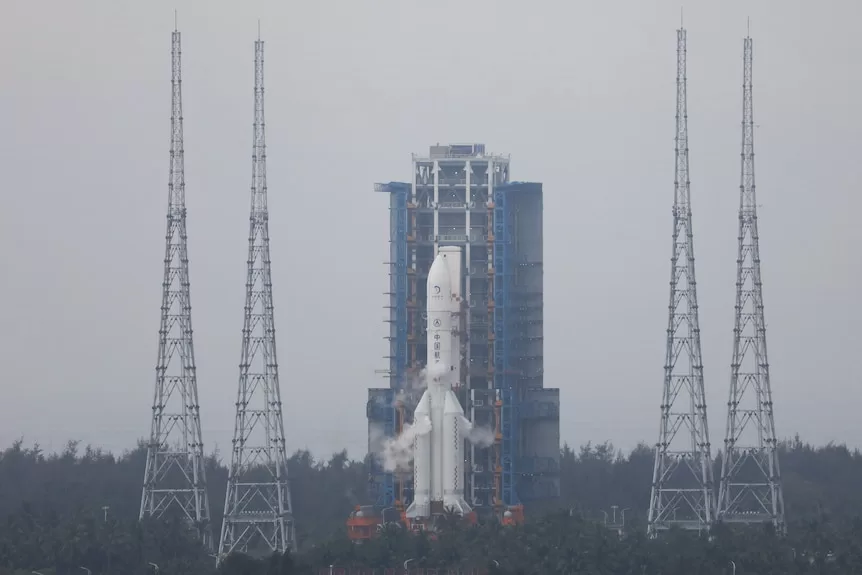- In short: China has launched a probe to collect soil and rock samples from the far side of the Moon.
- State media broadcast the launch and hailed it a success.
- What’s next? The mission is set to take 53 days and aims to collect samples with a geological age of 4 billion years.
China has launched what it says is a world-first probe to collect samples from the far side of the Moon, as Beijing pushes ahead with an ambitious program that aims to send a crewed lunar mission by 2030.
It is the latest advance in China’s increasingly sophisticated space exploration program, which is now competing with that of the US, which is still the leader in space.
A rocket carrying the Chang’e-6 lunar probe blasted off from the Wenchang Space Launch Centre in southern China’s Hainan province just before 5:30pm local time on Friday.
Huge numbers of people crowded Hainan’s beaches to view the launch, which took place in the middle of China’s five-day May Day holiday.
As with other recent launches, the event was televised live by state broadcaster CCTV.
Free from exposure to Earth and other interference, the Moon’s somewhat mysterious far side is ideal for radio astronomy and other scientific work.
China’s probe has embarked upon a technically complex 53-day mission that will also see it attempt an unprecedented launch from the side of the Moon that always faces away from Earth.
“The whole mission is fraught with numerous challenges, with each step interconnected and nerve-wracking,” Wang Qiong, deputy chief designer of the Chang’e-6 mission, told the Xinhua news agency.
The probe is set to land in the Moon’s immense South Pole-Aitken Basin, one of the largest-known impact craters in the solar system.
Once there, it will scoop up lunar soil and rocks, and carry out other experiments in the landing zone.
It must then lift off from the Moon’s surface and retrace its steps back home.
The Chang’e-6 aims to collect around two kilograms of lunar samples from the far side of the Moon and bring them back to Earth for analysis.
State news agency Xinhua hailed it as “the first endeavour of its kind in the history of human lunar exploration”.
China’s space dream
Plans for China’s “space dream” have been sent into overdrive under President Xi Jinping.
Beijing has ploughed huge resources into its space programme over the past decade, targeting a string of ambitious undertakings in an effort to close the gap with the two traditional space powers — the United States and Russia.
It has notched several notable achievements, including building its own space station called Tiangong, or “heavenly palace”, to which it sent a fresh crew of three astronauts last month.
Beijing has landed robotic rovers on Mars and the Moon and made China only the third country to independently put humans in orbit.
China aims to send a crewed mission to the Moon by 2030 and plans to build a base on the lunar surface.
The United States is also planning to put astronauts back on the Moon by 2026 with its Artemis 3 mission.
The rapid advance of China’s space program has raised alarm bells in Washington, with the head of NASA warning last month that the United States was now in a “race” against Beijing.
“We believe that a lot of their so-called civilian space program is a military program,” NASA administrator Bill Nelson told politicians on Capitol Hill.
Dark side exploration
Chang’e-6 is the first of three high-wire uncrewed missions to the Moon planned by China this decade.
Its successor, Chang’e-7, will scour the lunar south pole for water, while Chang’e-8 will attempt to establish the technical feasibility of building a planned base, known as the International Lunar Research Station, with Beijing saying a “basic model” will be completed by 2030.
Scientists say the Moon’s dark side — so called because it is invisible from Earth, not because it never catches the Sun’s rays — holds great promise for research because its craters are less covered by ancient lava flows than the near side.
That might mean it is more possible to collect material that sheds light on how the Moon formed in the first place.
“The samples collected by Chang’e-6 will have a geological age of approximately 4 billion years,” Ge Ping, vice-director of China’s Lunar Exploration and Space Engineering Center, told journalists.
AFP/AP/ABC
